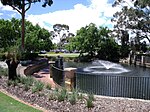Ascot Water Playground
Ascot, Western AustraliaBuildings and structures in Perth, Western Australia
The Ascot Water Playground is a former recreation facility in Ascot, Western Australia. Built in 1975 under the Labor government's Red Scheme for the long-term unemployed, it was officially opened in November 1977 at a cost of $326,156. The complex had pools, water slides, and mini-golf. The park closed in 2002 because of new occupational health and safety laws, as well as river run-off laws.It was added to the Municipal Heritage Inventory in 2003.
Excerpt from the Wikipedia article Ascot Water Playground (License: CC BY-SA 3.0, Authors).Ascot Water Playground
The Esplanade,
Geographical coordinates (GPS) Address Nearby Places Show on map
Geographical coordinates (GPS)
| Latitude | Longitude |
|---|---|
| N -31.93222 ° | E 115.93582 ° |
Address
The Esplanade
The Esplanade
6104 , Ascot
Western Australia, Australia
Open on Google Maps








